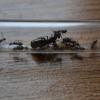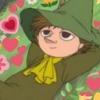Auroponera dakotensis
'Dakotan Needle Ants'
This is a Ponerinae species.
Range:
This species is endemic to the Black Hills of South Dakota. This small mountain range (that's taller than the Apalachains) was once an island in the middle of a large sea, and this species was thought to have first came about when this island still existed. It has since spread to other forested areas and suburban areas several hundred miles in any direction.
Diet:
This species breeds the springtail Myrmecophilus dakotensis in their nests. These springtails are large and meaty, providing the colony with all the amino acids necessary for healthy colony growth. The springtails will keep the nest free of mold, and the ants collect bits of leaf litter (preferably the needles of the Black Hills Spruce, one of the most common trees in the Black Hills, and the state tree of South Dakota), which the springtails feed on. Foragers will also collect honeydew from aphids and mealybugs.
Colony Structure:
Colonies are large, and may grow up to several hundred thousand workers. They are also polygynous and polydymous. Workers are monomorphic. A single colony may consist of several dozen nests, each containing thousands of workers. In territorial disputes, colonies will seize enemy nests, kill the workers, and adopt the queens and brood as their own.
Workers:
Workers are a bright orange color (In Latin, 'Auro' roughly translates as orange) and are around five millimeters in length. They have excellent eye sight, and are avid foragers. They will often engage in territorial disputes with other colonies. Workers have a painful sting. On average, they live around four to five years.
Queens:
Queens are glossy black with reddish thoraxes, and are around eight millimeters long. Nuptial flights occur in early to mid May.
Ergatoid Queens:
This species has actually properly developed ergatoid queens as a separate caste. These can only be produced by queens, as they require a specific gene sequence from queens. They are a millimeter or two longer than workers, yet are still orange. They have reddish thoraxes like queens, and wing scars. Ergatoid queens will mate in the nest, unlike queens, which require nuptial flights. Hundreds of ergatoid queens may be present within a colony. Ergatoid queens can also produce queens.
Ergatoid Workers:
These are similar to ergatoid queens in almost every way, except they are not nearly as productive as the primary reproductive castes. These do not require genetic sequences from the queen, and can be produced by ergatoid queens and gamergates. They themselves can produce queens.
Gamergates:
Gamergates are reproductive workers. They usually are designated as a gamergate shortly after eclosing from their pupae, and will develop a reddish thorax like queens. However, they are not any larger than workers, and all proportions are the same. Gamergates are the most unproductive of any reproductive caste, and will only produce one to two dozen offspring in their lives. When a colony is devoid of reproductives, normal workers may become gamergates, although they will not have the distinct reddish thorax.
Males:
Males are no different than males of other species. They are winged and wasp-like, and participate in nuptial flights. They are around five millimeters in length.
Wingless Males:
These males are wingless, and stay in the nest all their lives. They mate with ergatoid queens, ergatoid workers, and gamergates. They are slightly larger and better built than normal males, and may live for up to three years. These are the closest things ants have to kings, according to many biologists.
Edited by AntsDakota, April 20 2020 - 1:16 PM.




















